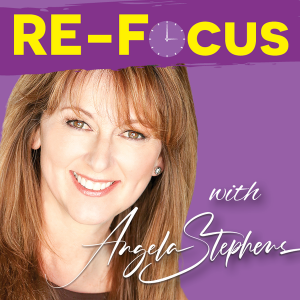Month: March 2021
The Truth about ADHD in Girls, and 5 Ways You Can Help
 Raquel is a bright, creative girl who likes singing, dancing around the house and riding her bike. She is an eighth grade girl with ADHD and mild dyslexia and receives support services at school through her IEP. She can be articulate, warm and funny. Raquel also has also developed a nice group of friends over the past year. Shana can be easily distracted and inflexible about routines. Her room is very disorganized and meals are difficult since she’s particular about her food and doesn’t like to hear other people chew. Bedtime and morning routines often deteriorate into yelling matches if she’s not getting what she wants immediately. In addition, she procrastinates about cleaning her room for months at a time. Life at home with her parents and two older siblings is marked by tension, arguments and disappointment, which nobody likes. For parents of girls with ADHD, can you relate?
Raquel is a bright, creative girl who likes singing, dancing around the house and riding her bike. She is an eighth grade girl with ADHD and mild dyslexia and receives support services at school through her IEP. She can be articulate, warm and funny. Raquel also has also developed a nice group of friends over the past year. Shana can be easily distracted and inflexible about routines. Her room is very disorganized and meals are difficult since she’s particular about her food and doesn’t like to hear other people chew. Bedtime and morning routines often deteriorate into yelling matches if she’s not getting what she wants immediately. In addition, she procrastinates about cleaning her room for months at a time. Life at home with her parents and two older siblings is marked by tension, arguments and disappointment, which nobody likes. For parents of girls with ADHD, can you relate?
Symptoms of ADHD in girls
Although the basic diagnostic criteria for ADHD are the same for all genders, ADHD often looks different for females than it does for males. While you may see signs of physical and verbal impulsivity and hyperactivity in your daughter, you are just as likely to see silliness or spaciness, shyness, daydreaming, perfectionism, anxiety, forgetfulness, emotional dysregulation, trouble making and keeping friends and picking at themselves.
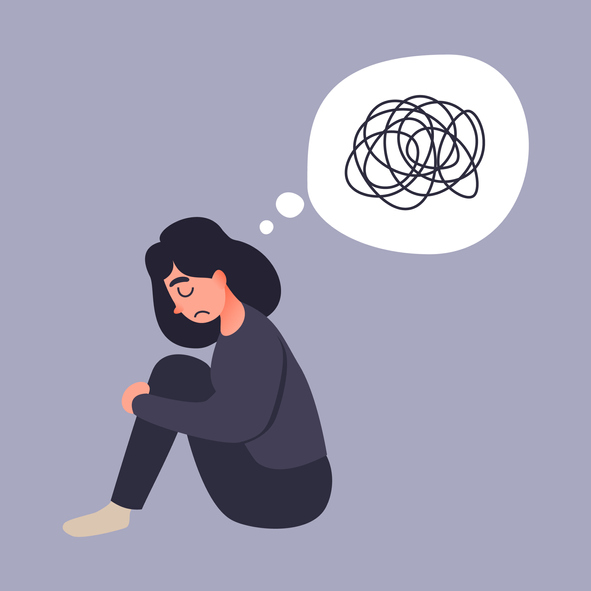
These signs can be overlooked in favor of boys who demonstrate more externalizing symptoms of ADHD and draw more attention from the teacher in class. For every girl who is diagnosed with ADHD, there are three boys with the condition.
How the presentation of ADHD in girls impacts a diagnosis
Girls with ADHD are diagnosed on average up to five years later than boys. Boys are diagnosed more often with hyperactivity/impulsivity, usually exhibiting inappropriate, aggressive or impulsive behaviors. Girls tend to have the inattentive type of ADHD, with more internal traits. This explains why we miss diagnosing ADHD in girls so much of the time. Both boys and girls with ADHD have brains that mature more slowly than neurotypical kids, with a lag of to three years. Higher rates of anxiety and depression often accompany ADHD in girls or may well overshadow or mask it altogether.
Unique challenges for girls with ADHD
While girls with ADHD can pay attention and focus well on things that interest or come easily to them, it’s their difficulties with uninteresting, unpleasant tasks where their ADHD brains struggle. Some deficits may be more obvious than others. Kendra gets to school on time but can’t keep your bedroom organized or meet deadlines for assignment. Zara gets her work done but is distracted so easily that it takes her twice as long as it should.
To make things more difficult, many girls with ADHD or LD will deny their executive functioning challenges and academic issues due to embarrassment or low self-worth.
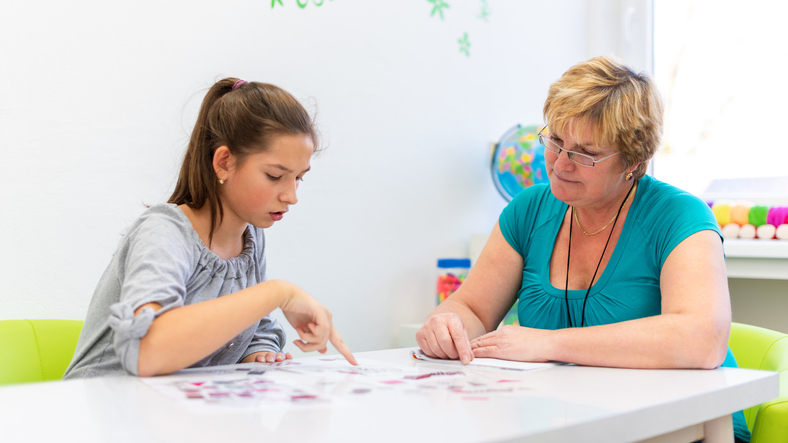
Ashamed of their difficulties and overwhelmed by frustration or fear about possible negative outcomes, some girls with ADHD will do anything to avoid disappointing friends and family, including themselves. Their challenges with verbal expression, auditory processing or verbal control make it harder for them socially. Girls are often conditioned to believe that they define themselves through their relationships. So when girls with ADHD misread cues or don’t hear what someone is saying because they are distracted or struggle to express themselves, they have a much harder time relating to their peers with the expected verbal connections.
Many girls will suffer silently rather than appear different from friends. Teachers and parents may miss seeing the ADHD that really exists as girls try to fly under the radar. Addressing this shame is a key feature of any therapeutic work for girls with ADHD. Of course, everybody with ADHD has serious executive functioning challenges, but all neurodivergent people have personal strengths.
Here are some ways that you can support girls with ADHD in your life:
1. Manage your own reactivity:
 When you are triggered by your daughter, it’s really difficult to show up as the parent you want to be. Figure out the internal signals that you are being set off and create a plan to calm yourself down.
When you are triggered by your daughter, it’s really difficult to show up as the parent you want to be. Figure out the internal signals that you are being set off and create a plan to calm yourself down.
Take a timed break from each other, go to the bathroom or step outside. Your emotional response will simply activate her even further.
In a calm moment, discuss what’s okay to say and do when she’s upset and what isn’t. Ask her to think of a logical consequence for cursing you out or a way that she can make amends for leaving a sink full of dirty dishes.
2. Set up weekly meetings:
To avoid nagging and arguments, sit down together once or twice a week. Assist them to organize their daily and weekly schedules and set up doable routines. Work with their desire for mastery and independence. Offer girls choices and incorporate their ideas for any programs you create. This will increase their buy-in.
3. Determine their executive functioning age:
Kids develop in uneven ways. They are stronger in some areas than others and this patterned development is especially true for both boys and girls with ADHD. If your daughter is 12, she may act 12 in her self-care (hygiene and ability to take care of the cat). But she may be more like a nine year-old in her organizational, planning and focus skills. Talk with her about her strengths and challenges and pick one skill to improve.
4. Make a study plan:
 Figure out together where, when and how homework or hybrid school will occur.
Figure out together where, when and how homework or hybrid school will occur.
If your daughter gets easily overwhelmed or distracted, help her (or ask the school to) break assignments down into smaller, manageable parts.
Teach her about time: what it feels like and how to work within its limits. This doesn’t come naturally to many kids with ADHD.
5. Offer empathy for their struggles:
Overcoming shame and learning how to advocate for herself are the best things you can teach your daughter to do. Perhaps you’ve had to learn these skills, too. What negative things does she say to herself? How can the two of you reframe these criticisms into something more positive? What tools does she need to talk honestly and non-judgmentally about her executive functioning challenges so she can get the accommodations and support she needs?
Recall times she’s faced her fears or her embarrassment before, and write down these moments of resilience. Hang it up in her room so she can look at the list. It’s too easy to forget the wins!
Read more blog posts:
- Moms with ADHD: Nurturing your power of authenticity
- Recognizing ADHD in Boys and 4 Ways to Help Them Succeed
- Gender, Sexuality and ADHD: Parenting Children and Youth with ADHD Exploring Their Gender and Sexual Identity
Watch on Dr. Saline’s YouTube Channel:
- How Do I Support My Daughter with ADHD? (ADHD Q&A with Dr. Sharon Saline)
- Moms with ADHD: Why YOU Are the Best Mother for Your Child (ADHD Q&A with Dr. Sharon Saline)
- How to Deal with & Educate ADHD Doubters (ADHD Q&A with Dr. Sharon Saline)
https://drsharonsaline.com/product/home-seminar/
5 Tips to Uplevel Your Spring Cleaning and Decluttering
 As the spring air settles in, the daylight hours get longer, and our positivity shifts. But that glistening sunshine may cast a harsh light on the parts of your home and your life that need a good reset after this COVID year. Spring cleaning and decluttering can ignite fresh ideas and increase productivity. Both cleaning and the resulting tidiness and spaciousness can help reduce stress and anxiety. This is a great time to get your house and your mental health in check as we transition back to ‘normal’. You’ll help yourself and your Neurodiverse kids to create an optimal ecosystem so the re-entry back to school feels organized and fresh. Follow these steps in our Spring Spankin’ Clean Checklist to get started and map out your plan of action.
As the spring air settles in, the daylight hours get longer, and our positivity shifts. But that glistening sunshine may cast a harsh light on the parts of your home and your life that need a good reset after this COVID year. Spring cleaning and decluttering can ignite fresh ideas and increase productivity. Both cleaning and the resulting tidiness and spaciousness can help reduce stress and anxiety. This is a great time to get your house and your mental health in check as we transition back to ‘normal’. You’ll help yourself and your Neurodiverse kids to create an optimal ecosystem so the re-entry back to school feels organized and fresh. Follow these steps in our Spring Spankin’ Clean Checklist to get started and map out your plan of action.
1. Strategize your spring cleaning and decluttering.
Instead of stressing about devoting an entire day or weekend to spring cleaning, take a different approach. It will probably be more productive for you to tackle different aspects of decluttering and cleaning in phases. Dedicate short windows of time to particular areas of your house, so the task feels less overwhelming. If trying to clean the kitchen, the office and living room in one day sounds like too (it does to me!), pick one room to approach.  Make a list of what you want to do, how much overall time you want to spend in that room and how your kids can assist you. Give them tasks that are age appropriate and fit their capabilities. Pick different days for projects too. Maybe spend 20 minutes vacuuming your rugs on Saturday, 30 minutes going through your dresser drawers on Sunday, and so on. This will make everything feel more manageable, especially when you have your munchkins helping you out.
Make a list of what you want to do, how much overall time you want to spend in that room and how your kids can assist you. Give them tasks that are age appropriate and fit their capabilities. Pick different days for projects too. Maybe spend 20 minutes vacuuming your rugs on Saturday, 30 minutes going through your dresser drawers on Sunday, and so on. This will make everything feel more manageable, especially when you have your munchkins helping you out.
2. Start with cleaning the space that inspires you and your kids.
What parts of disarray in the house bother you the most? What bothers them? If it happens to be your desk or their workspace, start to declutter there. If your kids’ imagination is sparked in the playroom or their rooms, head there. Your family thrives together in the kitchen? Optimize that space first. Together, collaborate on a plan of attack. What are you going to do first? What’s after that? You’re not just tidying up: you’re actually teaching them executive functioning skills like planning, prioritizing and organization along the way. Emphasize teamwork. How you approach this process and how you manage your frustration will set the tone for your decluttering process. Take short breaks to reset, have a drink or use the bathroom and then a longer break when you’ve completed a chunk of work.
3. Set donation goals.
It can be easy to forget that we don’t need every item in our homes… until spring cleaning comes around. I approach spring cleaning every year with a goal of donating items that I haven’t worn or used in several years and don’t think I will in the future.

Some of these items may be in bad shape and will head to the trash. But other things could interest or help other people. Create a few bags or boxes: keep, trash, donate. Assign or place items in these categories. By the end of my cleaning project, I may have a dozen things to sell at the consignment store or drop by the local donation thrift shop. Set goals like this with your kids too. They will have outgrown certain clothes or games and sharing them with others can give them a sense of purpose. It can be hard for some neurodivergent kids to let go of their stuff. If that’s true in your house, create a maybe bag as a transitional holding place. Then, you can revisit it in two weeks. Working together like this shows them know how to contribute to the household and to those less fortunate. Remember to use small incentives (like a new book or extra screen or outdoor time) to motivate them and keep them focused on the goal.
4. Organize your kids with Self-Smart Systems.
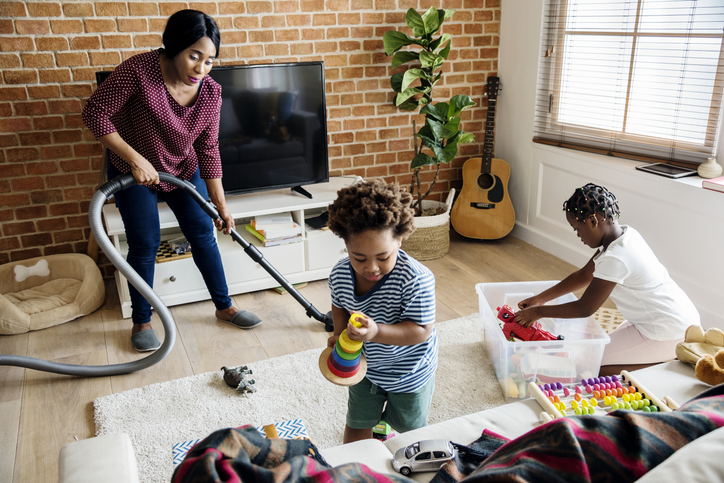 Start your organizing projects with your kids by asking them some questions. Instead of, “Why are your clothes always on the floor?” try, “I notice your clothes seems to end up on the floor. What might change that?” Kids with ADHD often have their own ideas about what makes sense to their brains in terms of managing their stuff. Some like to separate their clothes by color; others by function (tops, bottoms, etc.); others by seasons. Work with your child’s internal systems by expressing curiosity. “I wonder what would make it easier for you to see what’s in your drawers” or, “Let’s put the things you’re not really wearing in a plastic box and revisit this in a few months.” Ask, listen, participate and guide. When you do this, you become your child’s cleaning ally instead of their adversary.
Start your organizing projects with your kids by asking them some questions. Instead of, “Why are your clothes always on the floor?” try, “I notice your clothes seems to end up on the floor. What might change that?” Kids with ADHD often have their own ideas about what makes sense to their brains in terms of managing their stuff. Some like to separate their clothes by color; others by function (tops, bottoms, etc.); others by seasons. Work with your child’s internal systems by expressing curiosity. “I wonder what would make it easier for you to see what’s in your drawers” or, “Let’s put the things you’re not really wearing in a plastic box and revisit this in a few months.” Ask, listen, participate and guide. When you do this, you become your child’s cleaning ally instead of their adversary.
5. Consider storing winter or other seasonal items.
Blankets, coats, gloves, hats, bathing suits, flip flops, beach toys. You don’t need access to all of these things all year long. Decide what you will need and use and then put away the other stuff. For people living in cooler climates, may winter items can be bulky and take up lots of space. When there’s fewer items in the environment, it’s easier for kids with ADHD (and their parents) to see their options and use their stuff. To deal with unnecessary items, consider vacuum sealing. First, your son or daughter will think it’s the coolest thing ever and probably will help you. Who doesn’t want to see stuff shrink? These packages will take up less space so that your closets look and feel more streamlined. 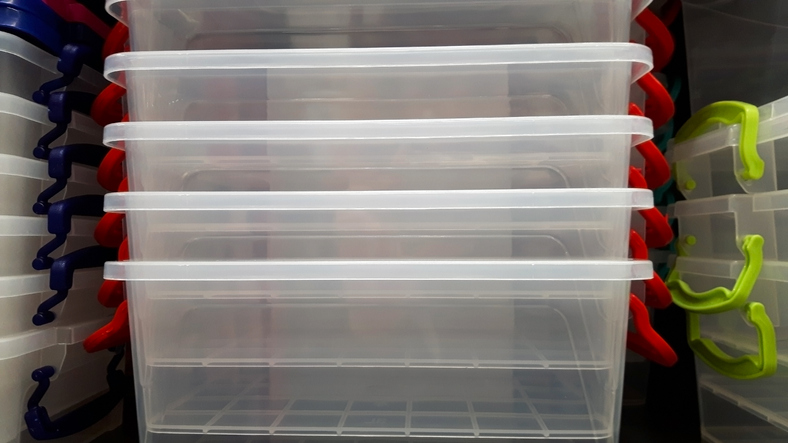 Another option is using plastic storage bins. I love these! Label the boxes and put them out of sight. When winter returns next year, you’ll be able to see and locate everybody’s stuff more quickly. Of course, if you find items that are outgrown or used very little this winter, pass them along to others! Spring cleaning and decluttering can refresh the mind, body, and spirit. Set aside specific times on the family calendar to tidy up. Whatever steps your family takes now, you’ll reap the benefits that much sooner!
Another option is using plastic storage bins. I love these! Label the boxes and put them out of sight. When winter returns next year, you’ll be able to see and locate everybody’s stuff more quickly. Of course, if you find items that are outgrown or used very little this winter, pass them along to others! Spring cleaning and decluttering can refresh the mind, body, and spirit. Set aside specific times on the family calendar to tidy up. Whatever steps your family takes now, you’ll reap the benefits that much sooner! 
Read more blog posts:
- Feeling overwhelmed by something? Break it down!
- Teens, ADHD and Procrastination
- ADHD and Motivation: How stress reduces productivity and what you can do about it
Handouts, videos & more in Dr. Saline’s Store: https://drsharonsaline.com/product/motivation/ https://drsharonsaline.com/product/home-seminar/
22 News Mass Appeal: Four ways to prevent our continued virtual life from keeping us feeling down
Raising Teens with ADHD: Redefining what ‘success’ means
 Let’s face it, raising teens today is challenging. With 24/7 access to screens, peers and entertainment, it’s tough to set boundaries, especially during a pandemic. Regardless of their words, actions or attitudes, most teens dislike family conflict as much as their parents do. Parenting “a successful teen” means working together on creating expectations, goals and strategies that foster connected independence. Everybody has a different definition of “success.” What’s important for parents raising teens with ADHD to do is to meet them where they are–not where you think they should be. This embodies a strong, parent-child connection that sets the stage for successfully addressing any issues. While there is a lot of emphasis on getting good grades, admissions to schools and colleges and awards for extracurricular activities as demonstrating ‘success’ for teens with and without ADHD, I believe that true ‘success’ for teens depends more on building lifelong tools for resilience and self-worth. When neurodiverse teens are able to tolerate and recover from disappointments, see mishaps as learning opportunities instead of failures, and believe that they have personal value regardless of their accomplishments, then they can be successful.
Let’s face it, raising teens today is challenging. With 24/7 access to screens, peers and entertainment, it’s tough to set boundaries, especially during a pandemic. Regardless of their words, actions or attitudes, most teens dislike family conflict as much as their parents do. Parenting “a successful teen” means working together on creating expectations, goals and strategies that foster connected independence. Everybody has a different definition of “success.” What’s important for parents raising teens with ADHD to do is to meet them where they are–not where you think they should be. This embodies a strong, parent-child connection that sets the stage for successfully addressing any issues. While there is a lot of emphasis on getting good grades, admissions to schools and colleges and awards for extracurricular activities as demonstrating ‘success’ for teens with and without ADHD, I believe that true ‘success’ for teens depends more on building lifelong tools for resilience and self-worth. When neurodiverse teens are able to tolerate and recover from disappointments, see mishaps as learning opportunities instead of failures, and believe that they have personal value regardless of their accomplishments, then they can be successful.
Parents can cultivate these aspects of ‘success’ by doing two main things:
 First, offer encouragement and validation of your child’s efforts as much as their achievements. Secondly, nurture positive connections in your parent-teen relationship. This connection fosters self-esteem and self-confidence. When teens with ADHD feel like their parents believe in them, value their opinions and listen to what they have to say, they are more likely to feel better about themselves. In addition, they are more likely to bounce back from obstacles and believe in their own capabilities. This is what ‘success’ looks like in an adolescent.
First, offer encouragement and validation of your child’s efforts as much as their achievements. Secondly, nurture positive connections in your parent-teen relationship. This connection fosters self-esteem and self-confidence. When teens with ADHD feel like their parents believe in them, value their opinions and listen to what they have to say, they are more likely to feel better about themselves. In addition, they are more likely to bounce back from obstacles and believe in their own capabilities. This is what ‘success’ looks like in an adolescent.
Here are some tips for parents to raise “successful teens” with ADHD.
Practice compassion for yourself and them.
Everybody is doing the best they can with whatever tools and resources they have available at a given moment. The push-pull of this stage of development is confusing and challenging for all of you. When kids are acting out, they lack adequate coping skills for whatever situation they’re facing. Try to recall what your adolescence was like: the awkwardness, the peer pressure and the insecurity. This empathy makes a huge difference. Be kind to yourself and patient with them as you navigate this territory.
Offer less advice and collaborate on goals.

Teens want to feel listened to more than they want you to solve their problems. Use reflective listening so they feel heard and validated. Repeat what you hear them say before giving advice or telling what to do. Work together on establishing goals for school, chores and self-care. When kids with ADHD participate in setting up expectations with their parents, they are far more likely to buy into whatever plan is created.
Create consistent routines that build executive functioning skills:
Aim for steadiness, not perfection. When it comes to raising teens with ADHD, you want to teach them tools for organization, planning, prioritizing, time management, initiation and self-care. Routines foster these skills. Use incentives instead of punishments to enhance motivation and connect the have-to’s to the want-to’s such as extra screen time, driving lessons with you and going out.
Set screen limits.
Assist your son or daughter in making gaming, social media and surfing the net a part of a balanced life not the main attraction. They can’t do this themselves. Create screen free family times such as meals, walks or games where you can be with each other and have fun. Remember that, despite what your teens tell you, screen time is a privilege, not something they are entitled to.
Encourage efforts, not just accomplishments.
Paying attention to the process of working on tasks, and not just their completion, encourages teens to keep trying and stick with goals. Underneath whatever bluster they present, teens with ADHD want to feel like what they do matters and is acknowledged by their parents. Little positive comments go a long way. 
Read more blog posts:
- 6 Helpful Tips for Dealing with Rejection Sensitive Dysphoria
- 5 Tips for Parenting Neurodiverse Kids on the Same Page
- Perfectionism and ADHD: Why ‘good enough’ is better than perfect
Learn more in Dr. Saline’s store:
https://drsharonsaline.com/product/live-adhd-webinar-beyond-high-school-graduation-how-to-help-neurodivergent-teens-prepare-for-their-next-chapter/ https://drsharonsaline.com/product/home-seminar/
RE-Focus Podcast EP 39: Managing your child’s risky behaviors
Overcoming Distractions Podcast: EP 107: Ditch negative thinking and develop a positive mindset with your ADHD
ADHD and Technology: Sensible Solutions to Screen (In)Sanity
 Do you feel like your child with ADHD has turned into a tech-obsessed stranger? If so, you are not alone. Many parents and caregivers are distraught and overwhelmed by the role that technology now plays in the lives of their children and teens. While you may sometimes want to throw the iPad, Chromebook, smartphone, etc. out of the window, I recommend that you take a deep breath and create a plan for a balanced media diet instead. The relationship between ADHD and technology can be positive, and a healthy balance will benefit your child and your family.
Do you feel like your child with ADHD has turned into a tech-obsessed stranger? If so, you are not alone. Many parents and caregivers are distraught and overwhelmed by the role that technology now plays in the lives of their children and teens. While you may sometimes want to throw the iPad, Chromebook, smartphone, etc. out of the window, I recommend that you take a deep breath and create a plan for a balanced media diet instead. The relationship between ADHD and technology can be positive, and a healthy balance will benefit your child and your family.
The acronym SCREENS can assist you with managing ADHD and technology:

Start with reasonable goals.
Collaborate on your technology plan.
Redirect to agreed-upon alternatives.
Expect pushback and decide in advance what to do.
Employ Easy on/Easy off technique.
Notice cooperation and nurture consistency.
Screens stay out of bedrooms at night.
Putting SCREENS to practice for ADHD and technology at home:
START with reasonable goals about media use right now.
During COVID, kids are on their technology more, plain and simple. But this doesn’t mean that they should have free rein over screen use in your family. What do you think is a reasonable daily amount of screen time? What do they think? If you are unsure, talk with your pediatrician or primary care provider for their advice on balancing ADHD and technology. The goal is balancing the high dopamine activities of online stimulation with lower dopamine periods to rebalance brain chemistry and settle down.
COLLABORATE on a plan about when and where screen time occurs.
 All screen time is not equal: there’s a difference between TikTok, texting, Snapchat, gaming, surfing the net and watching television. Talk about these differences and how to equalize them. Then, find neutral ground between what your kids want and what you think is best. The bar may be lower now due to COVID, and that’s okay. Let them know it’s an evolving situation where things can change.
All screen time is not equal: there’s a difference between TikTok, texting, Snapchat, gaming, surfing the net and watching television. Talk about these differences and how to equalize them. Then, find neutral ground between what your kids want and what you think is best. The bar may be lower now due to COVID, and that’s okay. Let them know it’s an evolving situation where things can change.
REDIRECT and be very clear about what qualifies as inappropriate use of technology.
Sexting, online bullying, visiting unsuitable sites, sneaking devices and being online at 2 a.m indicate a lack of respect about screen privileges. Discuss these differences and set up logical consequences for these type of behaviors. In addition, set up ways for your child to earn back your trust.
EXPECT PUSHBACK and you will not be surprised when it arises once again.
 Your child or teen will not thank you for creating screen time as an earned privilege. In fact, they will most likely become angry and tell you that being online is their right. I don’t agree. Our children are entitled to food, clothing, shelter, love, healthcare, education and a secure environment. Screen time is not on this list. Instead, I see it as a ‘want-to” that follows the ‘have-to’s’ of life. Have a plan in place for this so you are prepared. Also, be sure to monitor your own screen use. Kids with ADHD can smell hypocrisy a mile away. They will howl if adults stay on their phone at dinner but the kids’ phones are relinquished for a quiet meal.
Your child or teen will not thank you for creating screen time as an earned privilege. In fact, they will most likely become angry and tell you that being online is their right. I don’t agree. Our children are entitled to food, clothing, shelter, love, healthcare, education and a secure environment. Screen time is not on this list. Instead, I see it as a ‘want-to” that follows the ‘have-to’s’ of life. Have a plan in place for this so you are prepared. Also, be sure to monitor your own screen use. Kids with ADHD can smell hypocrisy a mile away. They will howl if adults stay on their phone at dinner but the kids’ phones are relinquished for a quiet meal.
EMPLOY EASY ON/EASY OFF TECHNIQUE and think about the role that you want technology to play in your family.
Decide how much screen time (not for school) you want your child or teen to have daily. Have a conversation about how much they desire. Then, decide on a baseline amount and a bonus amount of time. Perhaps the baseline is one hour after homework is completed and another two hours for earned time. How kids EASE OFF baseline once it is completed determines if they earn some of the bonus time. You can also attach bonus time to completion of chores, lack of yelling or cursing, readiness for school, going to bed on time, etc. Any desired behavior should be linked to earned screen time. Write down your plan and post it in the kitchen so it can be referred to easily.
NOTICE AND VALIDATE COOPERATION; managing ADHD and technology is not easy.
 Notice and validate any cooperation your child offers and expect to adjust the plan along the way. Balancing ADHD and technology as a child or teen is really difficult! Pick a time for a short weekly family meeting to discuss the earned privileges plan (maybe give it a snappy name) and how it’s going. Expect to make adjustments, but do not do this in the middle of an escalation. Your child will exert many tactics to get you to back down. Stay steady!! Let them know that all changes can be discussed in the weekly meeting and that negotiation does not mean they will get what they want. A good compromise occurs when everybody is a bit unhappy with the agreement.
Notice and validate any cooperation your child offers and expect to adjust the plan along the way. Balancing ADHD and technology as a child or teen is really difficult! Pick a time for a short weekly family meeting to discuss the earned privileges plan (maybe give it a snappy name) and how it’s going. Expect to make adjustments, but do not do this in the middle of an escalation. Your child will exert many tactics to get you to back down. Stay steady!! Let them know that all changes can be discussed in the weekly meeting and that negotiation does not mean they will get what they want. A good compromise occurs when everybody is a bit unhappy with the agreement.
SCREENS STAY OUT OF BEDROOMS AT NIGHT to avoid sneaking and using technology at inappropriate times.
Our brains need a break from looking at a screen to integrate, regroup and rest. Middle-of-the night texting, gaming or watching YouTube videos disrupts kids’ sleep and makes for tired, cranky children. Set up a screen-free family time during the day (meals, chores, games, baking, sports, etc.). This will give kids a chance to connect with others and practice real time social skills. It will also foster closer relationships with you through conversation and activity.
Good luck, and remember that any change takes time, practice and patience to take hold!
Read more blog posts:
- ADHD and Screen Sanity: Why a digital break is good for everybody right now
- Regulate Summer Screen Time for Your Child with ADHD and Yourself
- ADHD, Defiance and COVID: What can you do instead of yelling?
Learn more:
- From Screen Time to Safe Socializing: The Summer 2020 Guide for ADHD Families (Additude Magazine article by Dr. Saline)
https://drsharonsaline.com/product/managing-technology-families-video/ https://drsharonsaline.com/product/online-learning-tips-for-parents-bundle/ https://drsharonsaline.com/product/smartphones/ Read more about ADHD
22 News Mass Appeal: Adapting to change: Tips for making effective adjustments
Perfectionism and ADHD: Why ‘good enough’ is better than perfect
 Do you have a child or teen who needs to get things right or else? Perfectionism can be motivating and debilitating. While it’s admirable to want to do our best and strive for academic, social and professional success, many folks with perfectionism and ADHD go beyond this desire to do well. They create unrealistic standards of success, compare themselves negatively to neurotypical peers and focus too much on the end result and not the process of getting there. Learning to aim for steadiness and ‘good enough’ can relieve pressure that kids with ADHD put on themselves, and that adults set for them as well.
Do you have a child or teen who needs to get things right or else? Perfectionism can be motivating and debilitating. While it’s admirable to want to do our best and strive for academic, social and professional success, many folks with perfectionism and ADHD go beyond this desire to do well. They create unrealistic standards of success, compare themselves negatively to neurotypical peers and focus too much on the end result and not the process of getting there. Learning to aim for steadiness and ‘good enough’ can relieve pressure that kids with ADHD put on themselves, and that adults set for them as well.
Perceived positives of perfectionism and ADHD
There are several helpful aspects of perfectionism that assist kids with ADHD to get started and keep going on tasks and projects. They want to achieve a personal standard, create a piece of work or express themselves with pride and satisfaction. Perfectionism also contributes to the productive side of worry. It helps people by encouraging planning and fostering initiation such as doing homework, getting to work on time or remembering to charge your phone.
The pitfalls of perfectionism
But, perfectionism also limits people, especially children and teens with ADHD. The unhelpful aspects of perfectionism and ADHD include:
- Self-criticism (negative self-talk)
- Rigidity (not completely right means failure)
- Fear of disappointment (self or others)
- Avoidance of failure (not trying because effort won’t earn desired result)
- Sensitivity to feedback (defensiveness)
- Discouragement/depression (low self-worth due to incomplete goals)
Anxiety and procrastination
 Perfectionism and ADHD can exacerbate anxiety and reflect worry about things we think we cannot control. When kids have experienced previous struggles with chores, homework or class assignments, they worry about whether they can perform necessary tasks. They aren’t sure that they’ve got what it takes to do what is being asked of them. They are concerned about possible failure and want to avoid any embarrassment. If your child struggles with organization and prioritizing, then they don’t know where to begin and how to maintain perspective which makes things worse. Finn, age 16, tells me “ It’s hard to let go of the little stuff because everything is important.” This is where perfectionism procrastination kicks in. Kids with ADHD can be so immobilized by their worry about messing up that they don’t get started. They tell themselves “If I can’t get this just right, why bother?” They attempt to limit future mistakes and reduce potential shame by putting things off. This concern about humiliation, combined with low self-confidence about their capability, lie underneath perfectionism procrastination in neurodiverse kids.
Perfectionism and ADHD can exacerbate anxiety and reflect worry about things we think we cannot control. When kids have experienced previous struggles with chores, homework or class assignments, they worry about whether they can perform necessary tasks. They aren’t sure that they’ve got what it takes to do what is being asked of them. They are concerned about possible failure and want to avoid any embarrassment. If your child struggles with organization and prioritizing, then they don’t know where to begin and how to maintain perspective which makes things worse. Finn, age 16, tells me “ It’s hard to let go of the little stuff because everything is important.” This is where perfectionism procrastination kicks in. Kids with ADHD can be so immobilized by their worry about messing up that they don’t get started. They tell themselves “If I can’t get this just right, why bother?” They attempt to limit future mistakes and reduce potential shame by putting things off. This concern about humiliation, combined with low self-confidence about their capability, lie underneath perfectionism procrastination in neurodiverse kids.
Reframing goals and expectations for kids with perfectionism and ADHD
 Reframing the goals and how to proceed on meeting them reduces perfectionism. The first step is to keep things simple. When you break tasks down into smaller, do-able parts, kids are more likely to make efforts and keep trying–even if things aren’t exactly right. The stakes are lower for kids with perfectionism and ADHD because things are smaller. Therefore, “mistakes” have less consequence or value. When they work on these tasks and complete them–imperfect but finished–they start to overcome perfectionism. When kids can accept that something is good enough, they start to build a standard to apply to bigger items. Of course, determining what is good enough comes from a collaborative conversation that might also include the school to set appropriate ideals. When they attempt and then complete these easier goals, they are learning the skills to accept the reality of imperfection that all of us deal with. There is a difference between accountability (owning and accepting what you do with honesty and calm) and perfectionism (needing everything to be a certain way and judging yourself negatively when it’s not).
Reframing the goals and how to proceed on meeting them reduces perfectionism. The first step is to keep things simple. When you break tasks down into smaller, do-able parts, kids are more likely to make efforts and keep trying–even if things aren’t exactly right. The stakes are lower for kids with perfectionism and ADHD because things are smaller. Therefore, “mistakes” have less consequence or value. When they work on these tasks and complete them–imperfect but finished–they start to overcome perfectionism. When kids can accept that something is good enough, they start to build a standard to apply to bigger items. Of course, determining what is good enough comes from a collaborative conversation that might also include the school to set appropriate ideals. When they attempt and then complete these easier goals, they are learning the skills to accept the reality of imperfection that all of us deal with. There is a difference between accountability (owning and accepting what you do with honesty and calm) and perfectionism (needing everything to be a certain way and judging yourself negatively when it’s not).
Together, set up a goal roadmap with your son or daughter.
A goal roadmap lays out the trail of where you want to go and how to get there. Most children and teens with ADHD cannot do this themselves. They need you (or a coach, therapist or learning support person) to assist with mapping out the territory: what needs to be done when, what’s acceptable in terms of quality and quantity, what is most important and what is less relevant. Then you outline the manageable steps along the way.
Focus on the process of living and learning.
People are supposed to make errors, regroup and try again. You can’t say enough to your child with perfectionism and ADHD. This is how learning occurs in the human brain. It fosters that essential growth mindset: one where they try things and derive value from efforting as much or more than outcome. We want to aid neurodiverse kids in accepting themselves as normal because they are perfectly imperfect, with strengths and challenges – just like the rest of us. 
Read more blog posts:
- 6 Helpful Tips for Dealing with Rejection Sensitivity Dysphoria
- Raising teens with ADHD: Redefining what ‘success’ means
- Negative Memory Bias and ADHD: Tips to Help Kids and Youth with ADHD Remember the Positives
Learn more from Dr. Saline’s interviews & more:
- Perfectionism, Shoulds & Adult ADHD (ADHD Support Talk Radio interview with Dr. Saline)
- How Does ADHD Relate to Perfectionism, Anxiety & Procrastination? (ADDitude Mag ADHD Parenting Q&A w/ Dr. Saline)
Deeper Dive: https://drsharonsaline.com/product/shame/ https://drsharonsaline.com/product/home-seminar/


